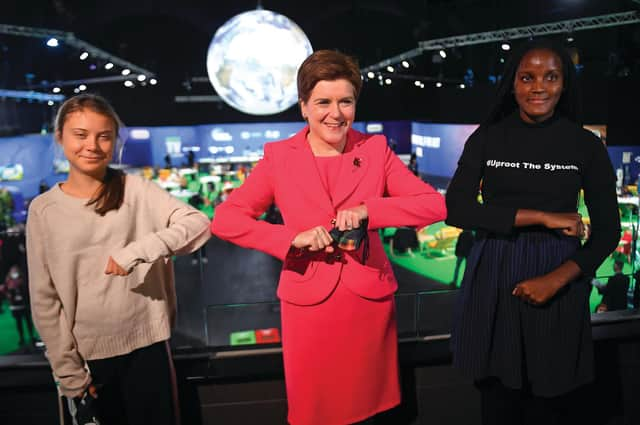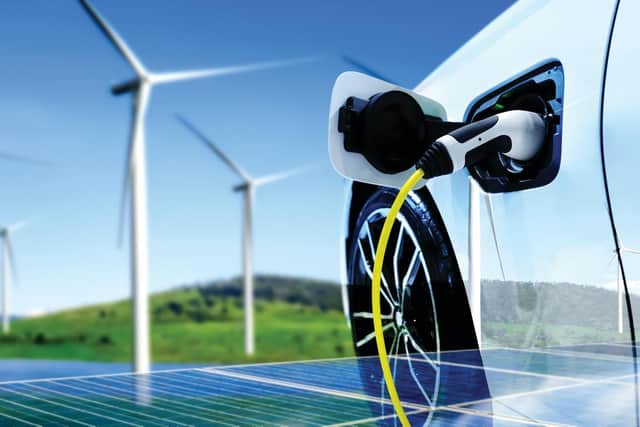Leading from the front to hit Scotland's ambitious net-zero target


The rest of the UK, and most other countries which have set net-zero targets, are aiming at 2050 – so will 2045 prove a step too far for Scotland in balancing out the amount of greenhouse gases it produces and the amount removed from the atmosphere?
We often hear about Scotland’s “world-leading” climate change legislation, and it has previously been described as “inspiring” by United Nations climate chief Patricia Espinosa. But is it enough?
Advertisement
Hide AdAdvertisement
Hide AdWhen asked ahead of COP26 if she thought Scotland was a global climate leader, young activist Greta Thunberg was unconvinced. She said she recognised that some countries “do a bit more than others”, but that none were coming close to what was needed.


So what is “needed”? Pretty much everything – including massive changes to decarbonise the great triumvirate of electricity, transport and heat.
Scotland got very close to its target of generating 100 per cent of its electricity from renewable sources in 2020, at 97.4 per cent, but electricity is only around one-quarter of energy used (for now –much more of it will be needed as electricity replaces fossil fuels). Transport also makes up roughly a quarter, while heat is arguably the biggest challenge, comprising around 50 per cent of energy consumption.
So how is Scotland doing on its net-zero journey? At the moment, it is off the pace. The latest figures, for 2019, show that greenhouse gas emissions were down 51.5 per cent on the 1990 baseline, but needed to be 55 per cent down at this point.
“We’re a little bit behind where we should be and need to go faster,” says Jamie Brogan, head of partnerships at the Edinburgh Climate Change Institute. “Measuring progress in real time against these targets is quite difficult. This isn’t an excuse, but there’s effectively a two-year time lag on national emissions data. So when you need changes of pace and scale, it’s difficult to see the cause and effect quickly.”
So what are the game-changers to make everything go faster? Offshore wind is taking off, with the technology and investment in place and a large pipeline of work. Energy storage is crucial, to tackle the intermittency challenge of renewables (see pages 8-9).
Large-scale carbon capture and storage (CCS) must happen too, so huge industrial sites such as Ineos at Grangemouth can decarbonise quickly. The Scottish Cluster, a consortium set up to fast-track CCS, missed out on the first round of UK Government funding, but is still hopeful of making a success of CCS tech here (see pages 10-11).
In tandem, the so-called “just transition” from oil and gas to cleaner energy sources has to pick up the pace. The challenge of that transition is embodied in the row over the proposed Cambo oil and gas field off Shetland, with critics claiming it would send out terrible signals to allow it to go ahead.
Advertisement
Hide AdAdvertisement
Hide AdOthers insist that gas will be needed as part of the energy mix through to 2050, including using it to produce “blue hydrogen” before “green hydrogen” can be made at scale. As Ronnie Quinn, head of industry decarbonisation collective Neccus, says starkly: “We can’t just switch off industry.”
If that happened, it could create an economic crisis, especially in north-east Scotland. The “transition” jobs in offshore wind, CCS, hydrogen and elsewhere are not yet available on a sufficient scale to plug the oil and gas employment gap. And turning off the gas taps could also create an energy crisis, with the real threat of rising prices and fuel shortages.
It’s not simple, and neither is another fundamental issue in the shift to net-zero – the money.
Enormous funding is needed, not only to finance large renewable energy and CCS projects, but to pay for the seismic changes in our lives, including how we travel and how we heat our homes.
One huge infrastructure project requiring vast sums of money is providing a comprehensive charging network for the shift to electric vehicles, as drivers face up to not being able to buy new petrol or diesel vehicles from 2030.
Another is decarbonising heat, especially the shift away from gas boilers. This is no easy or cheap fix. “It’s like the change from town gas to natural gas in the ’60s; to go from natural gas to hydrogen or other forms of heat supply, within the next ten to 20 years is an absolutely enormous project,” says Richard Cockburn, head of energy at legal firm Womble Bond Dickinson.
And the money cannot all come from governments. The private sector was out in force at COP26 –suggesting the winds of change are blowing through business and industry – but there are huge and complex challenges ahead, which require not just funding, but a change in mindset.
“The real game-changer is around values, behaviours and finance that will allow us to mobilise change and deliver benefits and deliver technologies at a local level,” says Brogan.
Advertisement
Hide AdAdvertisement
Hide AdTo do this also requires clear strategic policy direction in areas such as heat, electric vehicle charging and hydrogen.
Brogan says: “Hydrogen has a role, but we need to decide what that is, rather than looking at it as something that might be able to solve everything.
“It’s already being used in areas like public transport, HGVs, plant and agricultural vehicles, and even for back-up generators, but there needs to be the supply of green hydrogen to make this a really climate-friendly option.
“And we need a clear strategy on the best way to deploy charging points for electric vehicles, particularly where people can’t park in a driveway. Do you rely on businesses to put them in supermarket car parks, do you start to install them in street lighting, or replace existing garage infrastructure?”
However, Brogan says there are successes we can lean on to make the change needed: “We can learn from how we have decarbonised Scotland’s grid. If we invest and we commit, the cost of technologies comes down, and we’ll get to where we want to.
“But we’ve taken off most of the low-hanging fruit, in terms of decarbonisation as a society. Now, it’s about smarter and more localised solutions to balance supply and demand for capacity and availability – more local generation and energy storage.
“The UK hasn’t sorted out energy storage, how to flatten out that demand and supply. That’s why we have to keep fossil fuels as part of our mix, to cope with peak demand periods or when renewables aren’t working. We need fossil fuels in the mix until we nail the storage issue.”
John Boyce, head of wind projects at RES, which manages more than 7.5 GW of renewable assets in Scotland, agrees that storage is crucial – as well as the pace of change.
Advertisement
Hide AdAdvertisement
Hide AdHe says: “To deliver net-zero by 2045 will require a ramping up of renewable deployment at a faster pace than we’ve seen to date across Scotland. This means more onshore wind coupled with flexibility on the system such as battery energy storage. Decarbonisation of the power sector is within our reach and to tackle heat, transport and industry, we’ll need greater electrification powered by renewable energy.”
Brogan says that more people and more resources will also be needed – and there are no simple answers.
“People are looking for us to come up with magic bullets,” he says. “But, like everyone working in climate change, we’re completely under-resourced in the face of the scale of the challenge we face and the scale at which solutions need to be delivered to make meaningful inroads.
“Nobody’s really decided whose problem climate change is and who needs to pay to fix it. The answer is all of us; the market won’t get there by itself.”
So is Scotland ready to rise to the challenge?
“What we see at the moment is a lot of policies, strategies, targets, and commitments and not enough actions, projects and programmes delivering change and driving down emissions,” Brogan explains. “But those targets and strategies are necessary steps on the way.
“I would much rather it was all happening quicker, but there are systematic and cultural barriers we need to find the collective will and strength to overcome if we’re going to make meaningful progress at the pace and scale needed to tackle the climate challenge.
“If you get beyond the, ‘blah blah blah’ soundbite, that’s the frustration that people like Greta Thunberg are articulating.”
So in the light of all this, can Scotland hit the target of net-zero by 2045?
Advertisement
Hide AdAdvertisement
Hide Ad“It’s achievable, if we’re willing to make the changes we need to make as policymakers, businesses and as a society,” says Brogan.
“If you’re asking me the art of the possible, yes, we can achieve this target. Is it realistic? Are we going to? If I was a betting man, I’m not sure.”
Unlocking finance is crucial
Jamie Brogan says a new job role of “climate bridge-builder” is needed to unlock the finance needed to get “difficult” projects moving. “There’s a lot of pent-up demand and ambition from the finance community, which is starting to realise a future zero-carbon society is not only a global imperative but also a good investment opportunity. But sometimes you’re missing someone to get in the middle of a pipeline of projects and capital from the investment community.”
He says: “Carbon emissions from domestic properties in Edinburgh are 29 per cent of city emissions and projected to be about 34 per cent by 2030 as the population grows.” Incentives are not always good enough for individuals to make changes – and some people simply cannot afford it. Brogan adds: “We can tackle this with collective investment that pays for itself, but there’s just so much complexity in where that investment comes from.”
He says: “Edinburgh has a lot of tenements and getting that shared investment is hard, even when your roof is caving in. We also have a huge proportion of rental flats, Airbnb and student flats, where people are running their property as a business. They’re not necessarily investing for the long term – so if you’re clever, you start to aggregate portfolios of projects.”
Brogan says this might be a district heating scheme or a co-ordinated community-wide approach to insulation, retro-fitting properties or installing heat pumps.
“For a district heating scheme, for example, you need everybody who will benefit to come together. You need to share investment, think about the long-term structure of the returns, and the revenue. We haven’t really mobilised that yet.”
Edinburgh Climate Change Institute and their partners in the Place-based Climate Action Network are developing a proposal to create local finance platforms that essentially bridge that gap between good climate projects and investment. It’s not a second job for under-resourced councils, frustrated academics or volunteers. It’s a proper job for someone to co-ordinate that, to mobilise everyone.”